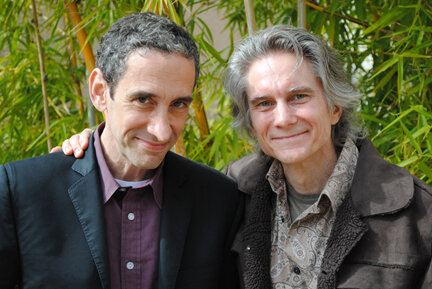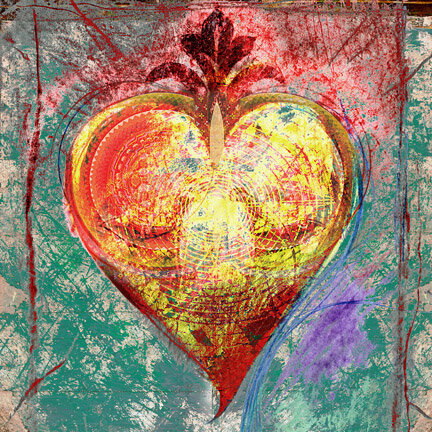The art department chairs and faculty at Brigham Young University are a dedicated bunch. For decades they have been taking students on trips around the country to meet working artists, industries that support them, and open their newly trained eyes to the possibilities of new worlds. Bob Barrett, one of the professors at BYU, along with his sturdy crew of faculty have stopped by my studio many times to talk about art career potential. I finally visited BYU early this year to lecture, and am returning June 15-17 to present an Artist As Brand workshop. I am amazed at the creative vitality in this college town and surrounding areas. The arts are very much supported here.
This post gives me a nice opportunity to celebrate Bob. For as long as I remember Bob has been a calm and determined creative force. 28 years teaching at BYU, also The University of Utah, The Kimball Center, The Salt Lake Art Center, and City Colleges of Chicago reflects his commitment to education. He has had a number of solo exhibitions at universities and art centers. Devoted to his family, faith, teaching, and art, Bob embodies a classical quality that is steadfast and timeless.
*Bob answered my questions in capitalized letters, so I decided to keep it that way.
Greg: You are very much respected as an educator and an artist. How would you define success?
Bob: I'M ACTUALLY MORE OF AN ILLUSTRATOR AS I WORK PRIMARILY THROUGH COMMISSIONED WORK; BOOK, EDITORIAL ILLUSTRATION, AND PORTRAITS. HOWEVER, I ALSO DO PERSONAL WORK.I THINK SUCCESS MEANS DIFFERENT THINGS TO DIFFERENT PEOPLE; TO ME IT MEANS FOLLOWING YOUR PASSION AND BEING ABLE TO FIND THE VIRTUES, RATHER THAN THE LIMITATIONS IN EVERY OPPORTUNITY. ATTITUDE HAS LOTS TO DO WITH IT. ON A PRACTICAL SIDE, I BELIEVE IT ALSO MEANS THAT YOU ARE ABLE TO MAKE A LIVING DOING WHAT YOU LOVE TO DO. TAKING CARE OF MY FINANCIAL RESPONSIBILITIES AND BEING ABLE TO PROVIDE GOOD THINGS FOR MY FAMILY HAS SOMETHING TO DO WITH SUCCESS FOR ME.
Twilight
G: Are you happy and content with your career, or do you desire something more?B: SO FAR I AM HAPPY WITH MY ACCOMPLISHMENTS THOUGH I BELIEVE A "HEALTHY DISSATISFACTION" STOPS ME FROM BECOMING COMPLACENT. I AM A PERSON WHO IS MOTIVATED BY LEARNING NEW THINGS AND HAVING NEW EXPERIENCES, SO I AM ALWAYS LOOKING FOR NEW OPPORTUNITIES. I LIKE TEACHING AND THE OPPORTUNITY TO GIVE BACK THINGS THAT WERE GIVEN TO ME BY OUTSTANDING TEACHERS ALONG THE WAY. THERE IS SOMETHING VERY REWARDING IN SEEING STUDENTS DEVELOP AND IMPROVE THEIR ABILITIES AND TALENTS.G: I love the statement:we are all standing on the shoulders of giants. We are learning all the time, and when that knowledge is shared we are encouraging self empowerment. How do you define artistic empowerment?B: I WOULD DEFINE ANY EMPOWERMENT, INCLUDING ARTISTIC, AS A SENSE OF CONFIDENCE IN YOUR ABILITIES AND IN THE OPPORTUNITIES LIFE PRESENTS TO YOU. SOME CALL IT A POSITIVE MENTAL ATTITUDE WHILE OTHERS MIGHT CALL IT THE ABILITY TO HAVE FAITH. I WOULD SAY IT HAS SOMETHING TO DO WITH MOTIVATION AND THE DRIVE TO SUCCEED. I HAVE TAUGHT MANY STUDENTS WITH TALENT WHO HAVE NOT DEVELOPED TO THE DEGREE THAT OTHERS WITH A SENSE OF SELF-EMPOWERMENT HAVE. I HAVE TAUGHT MANY STUDENTS HOW TO DRAW AND PAINT BETTER BUT ITS MORE ELUSIVE TO KNOW HOW TO TEACH THEM TO HAVE MOTIVATION.
Ballet Dress
G: Self motivation is key to empowered independence. This is why it's so important that your creativity and talent be aligned with what you love. BYU focuses on teaching conceptual and technical image making skill sets with an eye on preparing artists for the publishing, gallery, and entertainment industries. What could be some alternatives to these corporate models?B: SEVERAL OF OUR STUDENTS ARE HAPPY WORKING WITHIN THE TRADITIONAL STRUCTURES THAT ALREADY EXIST IN THE VARIOUS MARKETS YOU MENTIONED. HOWEVER, OTHERS WANT TO BE ENTREPRENEURS AND APPROACH THEIR CAREERS IN A MORE CREATIVE WAY. MANY OF OUR STUDENTS ARE FEMALE AND ASPIRE TO HAVE CHILDREN AND FAMILIES. THEY ARE LOOKING FOR ALTERNATIVES TO A CORPORATE MODEL. SEVERAL HAVE FOUND WAYS TO BALANCE AN ARTISTIC CAREER WITH THAT OF RAISING CHILDREN AND TAKING CARE OF A HOME. THEY HAVE STUDIOS IN THEIR HOME WHERE THEY DO THEIR CREATIVE WORK. SEVERAL ARE GREAT AT SELF-PROMOTION WHILE OTHERS HAVE AGENTS WHO PROMOTE THEIR WORK.G: Home based businesses are growing, especially when you understand how the internet can work for you. Its a whole new world of possibility. How you promote represents a huge part of your success. I have lots of artists ask me about agents. I tell them, no-one is going to sell yourself as well as you can. That being said, they can represent a stream of income if they are good at it. How would you describe artist sustainability?B: I SUPPOSE ARTISTIC SUSTAINABILITY IS LIKE ANY OTHER SUSTAINABILITY. YOU HAVE TO HAVE THE PASSION AND KNOWLEDGE OR SKILL SETS IN PLACE TO CONTINUE TO BE VIABLE. OUR MORE SUCCESSFUL STUDENTS, THOSE WHO HAVE ONGOING CAREERS SEEM TO BE THE ONES WHO KNOW HOW TO SOLVE PROBLEMS AND STAY "LIGHT ON THEIR FEET." THEY ARE FLEXIBLE AND ABLE TO MOVE AND CHANGE AS MARKETS CHANGE. THEY FIND THE OPPORTUNITIES IN A FLUCTUATING INDUSTRY.
Dancer
G: Flexibility is important. I encourage building an industry around your own art empire. That way you know where you are at any given point in any economy, because you have built a foundation that is based on loyal supporters. Artists are more limited when tied to a corporate structure. That being said, how do you handle fluctuating economic factors in the professional corporate world?B: WELL, I SUPPOSE ANY ONE WHO IS PRUDENT PUTS THINGS AWAY FOR A RAINY DAY. IN OTHER WORDS, HAVE SOME SAVINGS AND RESOURCES AVAILABLE TO CARRY YOU OVER WHEN THERE ARE DOWNTURNS IN THE ECONOMY OR WHEN THINGS CHANGE. I THINK IT IS ALSO HELPFUL TO NOT PLACE ALL YOUR ENERGIES IN ONE FIELD OR SPECIALIZATION. TO HAVE AND TO BE ABLE TO BALANCE SEVERAL "IRONS IN THE FIRE" IS OFTEN HELPFUL. IN MY OWN CASE, I DO ILLUSTRATION FOR A NUMBER OF CLIENTS BUT I ALSO TEACH AND DO WORKSHOPS. I AM ABLE TO PAINT PORTRAITS AS WELL AS LANDSCAPES AND ROUTINELY ENTER MY WORK IN EXHIBITIONS AND SHOWS. I HAVE WRITTEN A NUMBER OF ARTICLES FOR MAGAZINES AND TRADE PUBLICATIONS AS WELL AS A BOOK ON LIFE DRAWING. I BELIEVE IT IS ALSO HELPFUL TO ATTEND CONFERENCES AND WORKSHOPS - TO NETWORK AND EXPERIENCE NEW THINGS.G: Multiple streams of income is a smart strategy. Any thoughts or comments on Artist As Brand coming to BYU?B: I BELIEVE THIS IS A UNIQUE OPPORTUNITY FOR OUR STUDENTS AND FORMER STUDENTS TO DO EXACTLY THAT- ATTEND A WORKSHOP AND HAVE A NEW EXPERIENCE. THERE WILL BE AN OPPORTUNITY TO BE EXPOSED TO SOME GREAT PRINCIPLES RELATED TO SELF EMPOWERMENT BUT ALSO THE OPPORTUNITY TO SEE, MEET, AND NETWORK WITH OTHER ARTISTS.
G: What do you think a brand is? B: I SUPPOSE THE TERM MEANS FINDING AN IDENTITY, WHAT UNIQUELY LABELS OR DEFINES YOU AND WHAT YOU DO OR ARE INTERESTED IN DOING. SUCCESSFUL BRANDING IS THE ABILITY TO CREATE A PERSONALITY OR COMMODITY THAT IS ASSOCIATED MAINLY WITH YOU AND YOUR WORK.G: I ask this because the word "brand" appears to be a loaded term especially in fine art circles. I believe the word "brand" has been branded! However to be clear... A brand is a purpose transformed into a product or service that connects to people, the planet, and beyond. The key word here is purpose, and specifically your purpose.Any last pearls of wisdom?B: WE ARE LOOKING FORWARD TO HAVING YOU COME BACK TO BYU AND SHARE YOUR ENERGY AND ENTHUSIASM WITH US AND OUR STUDENTS AND ALUMNI.Thank you Bob! You are such a gentleman. It's an honor to know you and connect with your grand art spirit.I look forward to seeing you and all the talented individuals associated with BYU, June 15-17 for the workshop, and on the 19th for the Illustration Alumni Show. Lets energize our potential, and power up prosperity together.HERE ARE THE QUESTIONS FOR ALL BYU ALUMNI!1. HOW MANY OF YOU ARE ILLUSTRATORS? WHO IS HAPPY WITH THEIR CAREER AND MAKING ENOUGH INCOME TO PAY THEIR BILLS?2. HOW MANY OF YOU ARE WORKING IN THE FILM OR GAMING INDUSTRIES AND ARE HAPPY WITH YOUR CAREER? HOW MANY ARE ALREADY BURNED OUT?3. WHO IS SHOWING IN GALLERIES AND HAVING CREATIVE/ FINANCIAL SUCCESS?4. WHO FEELS LIKE THEIR CAREER IS JUST STARTING? HOW MANY FEEL YOUR CAREER IS OVER? WHO IS READY TO RE-INVENT THEMSELVES?5. WHO FEELS THEY ARE LIVING AND WORKING FROM THEIR HEART, AND DOING WHAT THEY LOVE? IS ANYONE READY TO TAKE THEIR LIFE, CREATIVITY, AND CAREER TO ANOTHER LEVEL OF FULFILLMENT?THANK YOU EVERYONE! I LOOK FORWARD TO YOUR ANSWERS.PeaceGreg


















